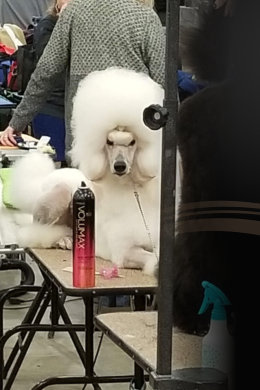






The Purity of Purebreds...
©David J. Arthur, April, 2011 On March 18, 2011, the United Kennel Club (UKC) officially recognized the Silken Windhound. Silkens are a medium-sized courser with all of the sighthound characteristics in a compact package. That sounds reasonable enough, and they should prove a nice addition to the registry. But what exactly is this new purebred? From the pictures, it’s a miniature Borzoi. But it’s not a Borzoi. It’s a Borzoi, Whippet, and Whippet-based lurcher blend. So isn’t that a mix? It’s not pure Borzoi, or it would be called a “Miniature”, like the Mini Australian Shepherd, right? Maybe it’s a Whippet mix that looks like a Borzoi? Either way, it’s a Silken now! Oh, lest anyone get their dander up, I say welcome to the Windhounds, and there is no intent to criticize the breed. Once recognized and approved, they are as pure a breed as any. And having not experienced them firsthand, I make no comment whatsoever on their disposition or upkeep. My point is more esoteric, and involves the concept of blending in general. It’s no secret there is a vast throng of breeds eligible for registration through any number of legitimate breed or all-breed registries. Each and every one is genuine in its own right. But in light of their origins – the Asian grey wolf – It draws the question as to what really constitutes a purebred in this era of designer dogs. Consider Poodles, where size does matter. They have been recognized as purebred for centuries, as it was just a matter of size selection. Of course, there were no written standards back when the Poodle shrank, and all of the varieties were codified upon their inception within the earliest registries. Today, most Poodles are segregated into three varieties, and in UKC they are further divided into two separate “breeds”, though only for show purposes. But even small derivations still cause controversy. For example, when the multi-colored Poodle was recognized by UKC, many of the solid breeders were just short of revolt! The “MCPs”, as they’re called, are still not acknowledged by the American Kennel Club (AKC). Then, let’s not forget the warfare over the Irish Red and White Setter. They’re now accepted in both UKC and AKC. And God forbid anyone shows up with a piebald Dachshund! There’s also plenty of consternation over Shiloh Shepherds and Miniature Aussies. Aren’t Shiloh’s just an oversized German Shepherd? Mate enough big ones together and “Voila”, over time you have a Shiloh, right? Not according to Tina Barber, the breed’s originator. Presently, they are relegated to a separate “breed”, recognized by neither AKC nor UKC. And the Mini Aussies aren’t even a variety yet, though there’s little question they will be a separate breed in time. Needless to say, the “regular” Aussie breeders are grabbing for their pitchforks. And have you ever wondered where American Hairless Terrier came from? In 1972, Edwin Scott had a litter of Rat Terriers, one of which was born bald. He liked the look, and began a breeding program to foster their creation. It wasn’t until 1999 that the UKC formally recognized the nekkid Ratties as a separate variety, and eventually a breed in 2004. Because they’re all basically Rat Terriers, the two breeds can be mixed ... which is cross-breeding, isn’t it? Not any more than Smooth or Rough Collies, I suppose. But those breeds aren’t blended with other breeds. The term “purebred” implies purity, right? Yet we see the Silken is clearly an amalgam of Borzoi, Whippets, and lurchers. And what are “lurchers”? Heck, they’re no breed at all. They’re a conglomeration of whatever dogs seem useful to their breeder at the time. So the term “Whippet-based” simply means that the lurchers in question are primarily Whippet mixes. So how can they be purebred? I guess it’s sort of like the Shetland Sheepdog. Now there’s a purebred ... or at least it is now. Of course, if you go back around the turn of the last century, the Sheltie looked a lot different than the miniature collie we see today. It began as a small generic Norse herding dog that landed on the Shetland Islands. Back then, it was fairly common to cross-breed dogs to get the necessary traits to fit your exact needs ... sort of like making a lurcher, I suppose. Anyway, those old Scottish breeders crossed Collies with the original “Toonie” dogs to standardize the Sheltie’s look. Doing that sent their size skyward, so to keep them small, they tossed in a few condensed Spitz breeds. Have you ever wondered where those occasional buggy eyes come from? They’re from the region of Pomerania, to be exact! The key is, Shelties are purebred, and have been for a hundred years. Silkens are recently “blended” ... then again, so also are Alaskan Klee Kais. The Klee Kai was developed in the mid 1970’s when Linda Spurlin quietly bred Huskies, Schipperkes, and American Eskimos together in the lonely wilds of Alaska. Then, in 1988, they were finally trotted out as a “new breed”, gaining UKC recognition in 1997. And so we have another “purebred”. Confused yet? Ok, let’s define “purebred”. According to Mr. Webster’s dictionary, it’s an: –adjective 1. of or pertaining to an animal, all of whose ancestors derive over many generations from a recognized breed. –noun 2. a purebred animal, especially one of registered pedigree. What does “many generations” mean? For a mix to become a breed, the resulting crosses must be combined until they breed true to a standard. Generally, that takes about seven generations, and so, the Silken Windhounds have prevailed, breeding true over the years to a lovely medium sized Borzoi-type sighthound. That still doesn’t answer why anyone would intentionally mix purebreds. I suppose it all comes down to purpose. Take the Doberman Pinscher, for example. Karl Frederich Louis Doberman, for which the breed was named, needed a sound and agile guardian while working as a tax collector. Nobody knows for sure, but he apparently bred German Shepherd-type dogs, Rottweilers, Black and Tan Terriers, German Pinschers, Manchester Terriers, and even Greyhounds to come up with our present “purebred”. His choices were based primarily on protection ability and temperament, and eventually on appearance. In 1899, the German Kennel Club gave them recognition. Thus the Dobe was deemed “purebred”. Function has always driven kennel plans, and even today, as we work to improve our lines, we hopefully are keeping a strict eye on what our breeds were wrought to do. And to what purpose is the Silken? It’s a courser, first and foremost, with nearly 20% of the breed actively competing. With a medium size, it’s ideal for home life, whereas the Borzoi’s larger scale can be a bit limiting when it comes to sharing the family sofa. So maybe “purebred” doesn’t exactly require total exclusivity at first. Heavens, all dogs are hybrids of one sort or another. But this doesn’t mean indiscriminate breeding is a worthy venture either. It’s a sure-fire way to lose the benefits our ancestors spent their lives trying to refine. We honestly must protect our purebred lines by being faithful to our standards and breeding true to that which has already been accepted and deemed “pure”. Either way, we now have a new breed, fully recognized, steeped in purpose, and effusively ready for the ring. Now let’s just hope the (insert breed prefix here)doodle isn’t next ... God forbid!



















